Study on Qualitative Impact Damage of Loquats Using Hyperspectral Technology Coupled with Texture Features
Abstract
:1. Introduction
- (1)
- To explore the feasibility of detecting the degree of bruising of loquats by multispectral techniques in the hyperspectral NIR region.
- (2)
- To confirm that the PC images in the hyperspectral NIR region can effectively distinguish bruised loquats from normal loquats.
- (3)
- To determine if the spectral data of three characteristic wavelength points in the hyperspectral NIR region coupled with texture features and gray information of the two-band ratio images method can be used to effectively detect the degree of bruising of loquats.
2. Material and Methods
2.1. Loquat Samples
2.2. Hyperspectral Image Acquisition System
2.3. Principal Component Analysis
2.4. Two-Band Radio Image
2.5. Morphological Segmentation Method
2.6. Gray Level Co-Occurrence Matrix
2.7. Least Squares Support Vector Machine
2.8. Multispectral Analysis Method
3. Results and Discussion
3.1. Spectra of ROIs in Samples
3.2. PCA in Vis–NIR Region
3.3. PCA in the Vis Region
3.4. PCA in the NIR Region
3.5. Morphological Segmentation Method
3.6. PCA in the Multispectral Image
3.7. Band Ratio Image
3.8. Classification of Bruised Loquats
4. Conclusions
Author Contributions
Funding
Data Availability Statement
Acknowledgments
Conflicts of Interest
References
- Zhang, S.; Wu, X.; Zhang, S.; Cheng, Q.; Tan, Z. An effective method to inspect and classify the bruising degree of apples based on the optical properties. Postharvest Biol. Technol. 2017, 127, 44–52. [Google Scholar] [CrossRef]
- Opara, U.L.; Pathare, P.B. Bruise damage measurement and analysis of fresh horticultural produce—A review. Postharvest Biol. Technol. 2014, 91, 9–24. [Google Scholar] [CrossRef]
- Besada, C.; Sanchez, G.; Gil, R.; Granell, A.; Salvador, A. Volatile metabolite profiling reveals the changes in the volatile compounds of new spontaneously generated loquat cultivars. Food Res. Int. 2017, 100, 234–243. [Google Scholar] [CrossRef] [PubMed]
- Ballester, C.; Buesa, I.; Soler, E.; Besada, C.; Salvador, A.; Bonet, L.; Intrigliolo, D.S. Postharvest regulated deficit irrigation in early- and intermediate-maturing loquat trees. Agric. Water Manag. 2018, 205, 1–8. [Google Scholar] [CrossRef]
- Munera, S.; Gómez-Sanchís, J.; Aleixos, N.; Vila-Francés, J.; Colelli, G.; Cubero, S.; Soler, E.; Blasco, J. Discrimination of common defects in loquat fruit cv. ‘Algerie’ using hyperspectral imaging and machine learning techniques. Postharvest Biol. Technol. 2020, 171, 111356. [Google Scholar] [CrossRef]
- Zhang, B.; Li, J.; Fan, S.; Huang, W.; Zhao, C.; Liu, C.; Huang, D. Hyperspectral imaging combined with multivariate analysis and band math for detection of common defects on peaches (Prunus persica). Comput. Electron. Agric. 2015, 114, 14–24. [Google Scholar] [CrossRef]
- Cubero, S.; Aleixos, N.; Moltó, E.; Gómez-Sanchis, J.; Blasco, J. Advances in machine vision applications for automatic inspection and quality evaluation of fruits and vegetables. Food Bioprocess Technol. 2011, 4, 487–504. [Google Scholar] [CrossRef]
- Patel, K.K.; Kar, A.; Khan, M.A. Common External Defect Detection of Mangoes Using Color Computer Vision. J. Inst. Eng. (India) Ser. A 2019, 100, 559–568. [Google Scholar] [CrossRef]
- Beyaz, A.; Gila, D.M.M.; Ortega, J.G.; García, J.G. Olive fly sting detection based on computer vision. Postharvest Biol. Technol. 2019, 150, 129–136. [Google Scholar] [CrossRef]
- Sabzi, S.; Javadikia, H.; Arribas, J.I. A three-variety automatic and non-intrusive computer vision system for the estimation of orange fruit pH value. Measurement 2020, 152. [Google Scholar] [CrossRef]
- Ali, M.M.; Hashim, N.; Hamid, A.S.A. Combination of laser-light backscattering imaging and computer vision for rapid determination of oil palm fresh fruit bunches maturity. Comput. Electron. Agric. 2020, 169, 105235. [Google Scholar] [CrossRef]
- Yan-de, L.; Meng-jie, C.; Yong, H. Application of spectral diagnoses technology in determination of agricultural products quality. J. East China Jiaotong Univ. 2018, 35, 1–7. [Google Scholar] [CrossRef]
- Folch-Fortuny, A.; Prats-Montalbán, J.; Cubero, S.; Blasco, J.; Ferrer, A. VIS/NIR hyperspectral imaging and N-way PLS-DA models for detection of decay lesions in citrus fruits. Chemom. Intell. Lab. Syst. 2016, 156, 241–248. [Google Scholar] [CrossRef]
- Liu, G.; He, J.; Wang, S.; Luo, Y.; Wang, W.; Wu, L.; Si, Z.; He, X. Application of near-infrared hyperspectral imaging for detection of external insect infestations on jujube fruit. Int. J. Food Prop. 2015, 19, 41–52. [Google Scholar] [CrossRef]
- Nturambirwe, J.; Perold, W.; Opara, U. Classification Learning of Latent Bruise Damage to Apples Using Shortwave Infrared Hyperspectral Imaging. Sensors 2021, 21, 4990. [Google Scholar] [CrossRef]
- Babellahi, F.; Paliwal, J.; Erkinbaev, C.; Amodio, M.L.; Chaudhry, M.M.A.; Colelli, G. Early detection of chilling injury in green bell peppers by hyperspectral imaging and chemometrics. Postharvest Biol. Technol. 2019, 162, 111100. [Google Scholar] [CrossRef]
- Wang, H.; Hu, R.; Zhang, M.; Zhai, Z.; Zhang, R. Identification of tomatoes with early decay using visible and near infrared hyperspectral imaging and image-spectrum merging technique. J. Food Process Eng. 2021, 44, e13654. [Google Scholar] [CrossRef]
- Yuan, R.; Guo, M.; Li, C.; Chen, S.; Liu, G.; He, J.; Wan, G.; Fan, N. Detection of early bruises in jujubes based on reflectance, absorbance and Kubelka-Munk spectral data. Postharvest Biol. Technol. 2021, 185, 111810. [Google Scholar] [CrossRef]
- Sun, Y.; Wang, Y.; Xiao, H.; Gu, X.; Pan, L.; Tu, K. Hyperspectral imaging detection of decayed honey peaches based on their chlorophyll content. Food Chem. 2017, 235, 194–202. [Google Scholar] [CrossRef]
- Cen, H.; Lu, R.; Zhu, Q.; Mendoza, F. Nondestructive detection of chilling injury in cucumber fruit using hyperspectral imaging with feature selection and supervised classification. Postharvest Biol. Technol. 2016, 111, 352–361. [Google Scholar] [CrossRef]
- Li, J.; Chen, L.; Huang, W.; Wang, Q.; Zhang, B.; Tian, X.; Fan, S.; Li, B. Multispectral detection of skin defects of bi-colored peaches based on vis–NIR hyperspectral imaging. Postharvest Biol. Technol. 2016, 112, 121–133. [Google Scholar] [CrossRef]
- Zhang, H.; Chen, Y.; Liu, X.; Huang, Y.; Zhan, B.; Luo, W. Identification of Common Skin Defects and Classification of Early Decayed Citrus Using Hyperspectral Imaging Technique. Food Anal. Methods 2021, 14, 1176–1193. [Google Scholar] [CrossRef]
- Xiong, J.; Lin, R.; Bu, R.; Liu, Z.; Yang, Z.; Yu, L. A Micro-Damage Detection Method of Litchi Fruit Using Hyperspectral Imaging Technology. Sensors 2018, 18, 700. [Google Scholar] [CrossRef] [PubMed]
- Li, J.; Luo, W.; Wang, Z.; Fan, S. Early detection of decay on apples using hyperspectral reflectance imaging combining both principal component analysis and improved watershed segmentation method. Postharvest Biol. Technol. 2018, 149, 235–246. [Google Scholar] [CrossRef]
- Munera, S.; Rodríguez-Ortega, A.; Aleixos, N.; Cubero, S.; Gómez-Sanchis, J.; Blasco, J. Detection of Invisible Damages in ‘Rojo Brillante’ Persimmon Fruit at Different Stages Using Hyperspectral Imaging and Chemometrics. Foods 2021, 10, 2170. [Google Scholar] [CrossRef]
- Sun, Y.; Lu, R.; Lu, Y.; Tu, K.; Pan, L. Detection of early decay in peaches by structured-illumination reflectance imaging. Postharvest Biol. Technol. 2019, 151, 68–78. [Google Scholar] [CrossRef]
- Salembier, P.; Pardàs, M. Hierarchical morphological segmentation for image sequence coding. IEEE Trans. Image Process. 1994, 3, 639–651. [Google Scholar] [CrossRef]
- Haralick, R.M.; Shanmugam, K.; Dinstein, I.H. Textural Features for Image Classification. IEEE Trans. Syst. Man Cybern. 1973, SMC-3, 610–621. [Google Scholar] [CrossRef]
- Dhruv, B.; Mittal, N.; Modi, M. Study of Haralick’s and GLCM texture analysis on 3D medical images. Int. J. Neurosci. 2018, 129, 350–362. [Google Scholar] [CrossRef]
- Gowen, A.A.; O’Donnell, C.P.; Taghizadeh, M.; Cullen, P.J.; Frias, J.M.; Downey, G. Hyperspectral imaging combined with principal component analysis for bruise damage detection on white mushrooms (Agaricus bisporus). J. Chemom. 2008, 22, 259–267. [Google Scholar] [CrossRef]
- Wei, X.; Jia, K.; Lan, J.; Li, Y.; Zeng, Y.; Wang, C. Automatic method of fruit object extraction under complex agricultural background for vision system of fruit picking robot. Optik 2014, 125, 5684–5689. [Google Scholar] [CrossRef]
- Nascimento, P.A.M.; de Carvalho, L.C.; Júnior, L.C.C.; Pereira, F.M.V.; Teixeira, G.H.D.A. Robust PLS models for soluble solids content and firmness determination in low chilling peach using near-infrared spectroscopy (NIR). Postharvest Biol. Technol. 2016, 111, 345–351. [Google Scholar] [CrossRef]
- Ayele, B.T.; Magnus, V.; Mihaljević, S.; Prebeg, T.; Čož-Rakovac, R.; Ozga, J.A.; Reinecke, D.M.; Mander, L.N.; Kamiya, Y.; Yamaguchi, S.; et al. Endogenous gibberellin profile during Christmas rose (Helleborus niger L.) flower and fruit development. J. Plant Growth Regul. 2010, 29, 194–209. [Google Scholar] [CrossRef]
- Zhang, D.; Xu, L.; Liang, D.; Xu, C.; Jin, X.; Weng, S. Fast prediction of sugar content in dangshan pear (Pyrus spp.) using hyperspectral imagery data. Food Anal. Methods 2018, 11, 2336–2345. [Google Scholar] [CrossRef]
- Hu, R.; Zhang, L.; Yu, Z.; Zhai, Z.; Zhang, R. Optimization of soluble solids content prediction models in ‘Hami’ melons by means of Vis-NIR spectroscopy and chemometric tools. Infrared Phys. Technol. 2019, 102, 102999. [Google Scholar] [CrossRef]
- Meng, Q.; Shang, J.; Huang, R.; Zhang, Y. Determination of soluble solids content and firmness in plum using hyperspectral imaging and chemometric algorithms. J. Food Process Eng. 2020, 44, e13597. [Google Scholar] [CrossRef]
- Liu, Y.; Wang, T.; Su, R.; Hu, C.; Chen, F.; Cheng, J. Quantitative Evaluation of Color, Firmness, and Soluble Solid Content of Korla Fragrant Pears via IRIV and LS-SVM. Agriculture 2021, 11, 731. [Google Scholar] [CrossRef]
- Li, X.; Liu, Y.; Jiang, X.; Wang, G. Supervised classification of slightly bruised peaches with respect to the time after bruising by using hyperspectral imaging technology. Infrared Phys. Technol. 2020, 113, 103557. [Google Scholar] [CrossRef]
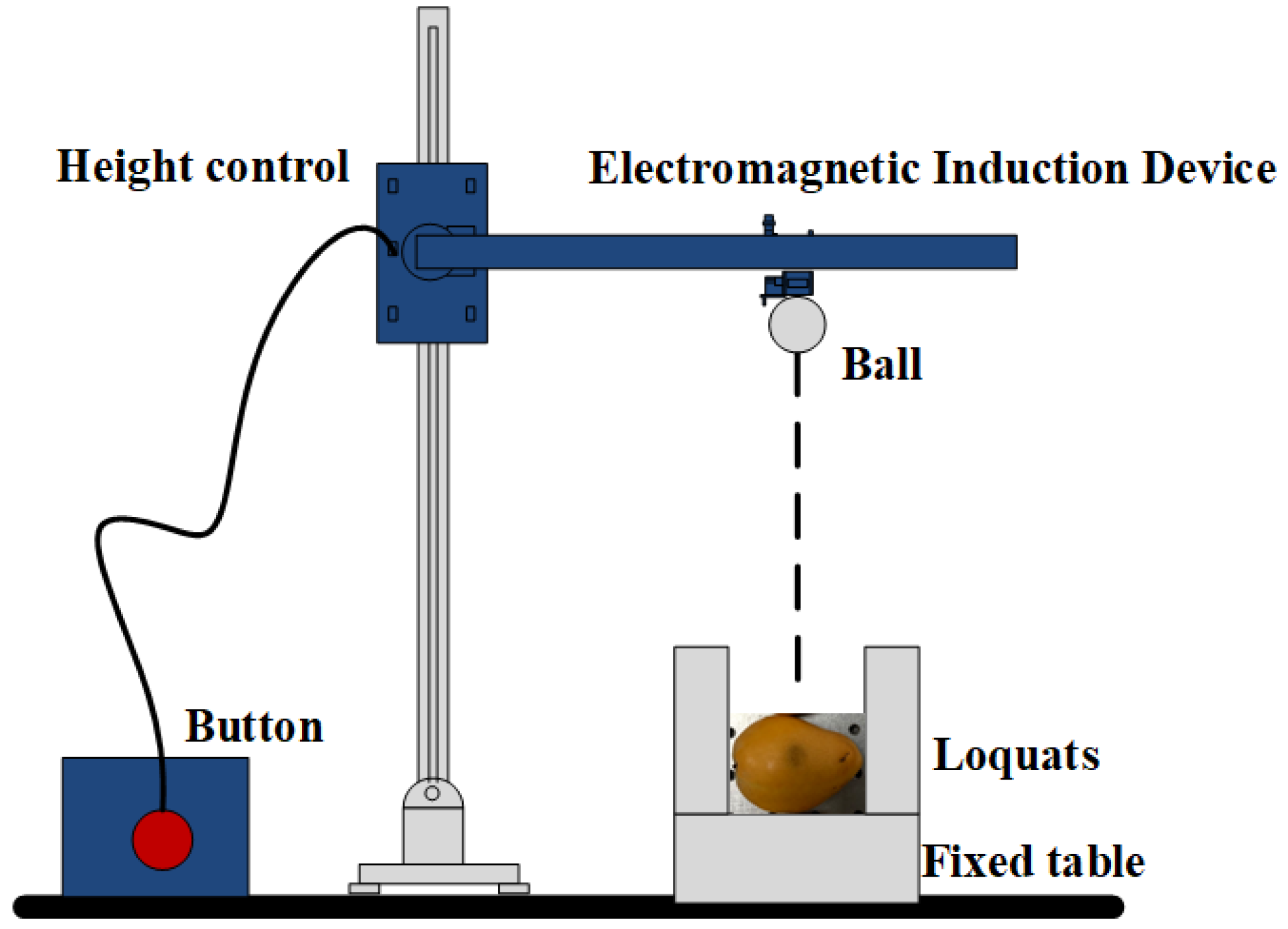
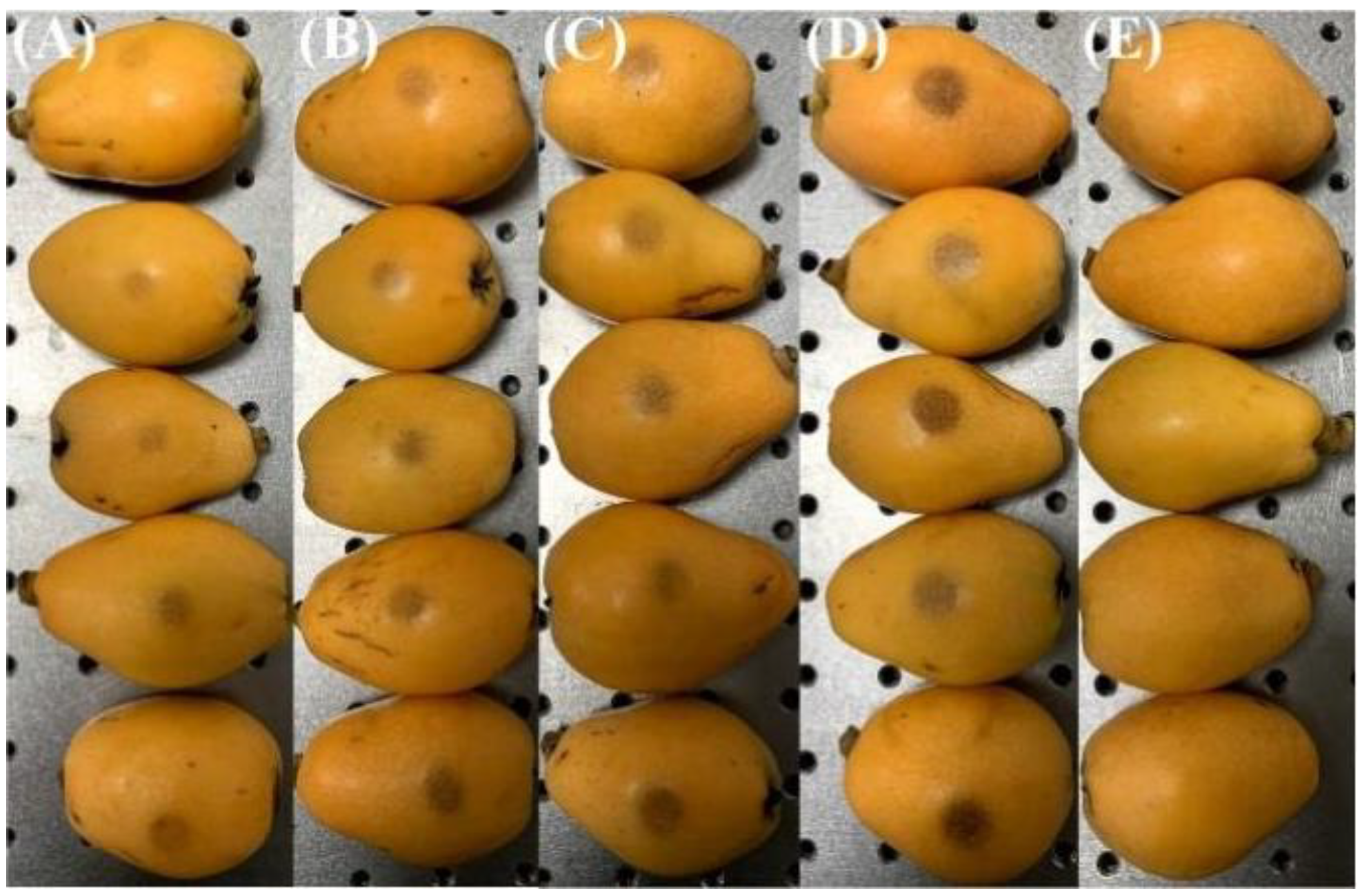
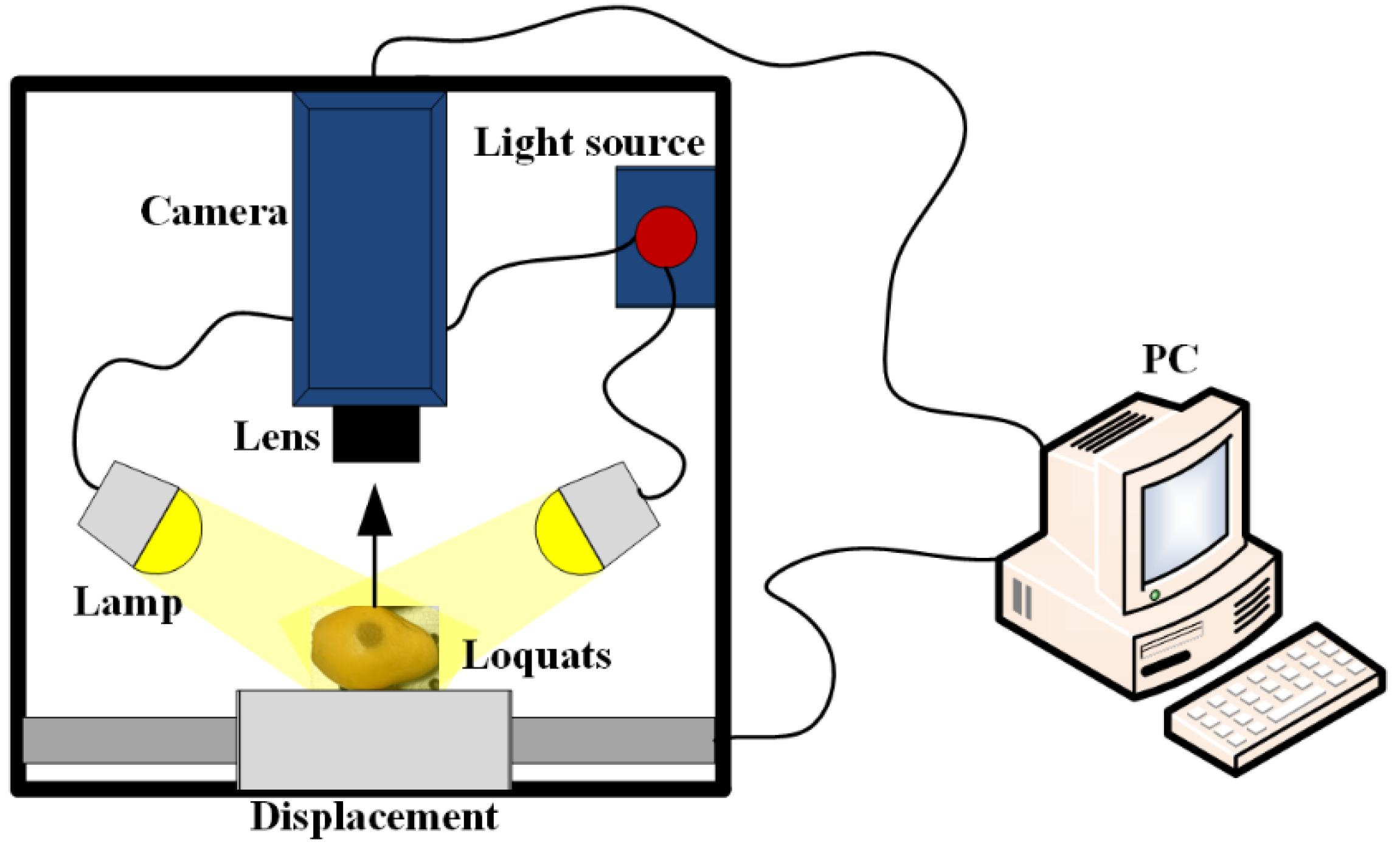
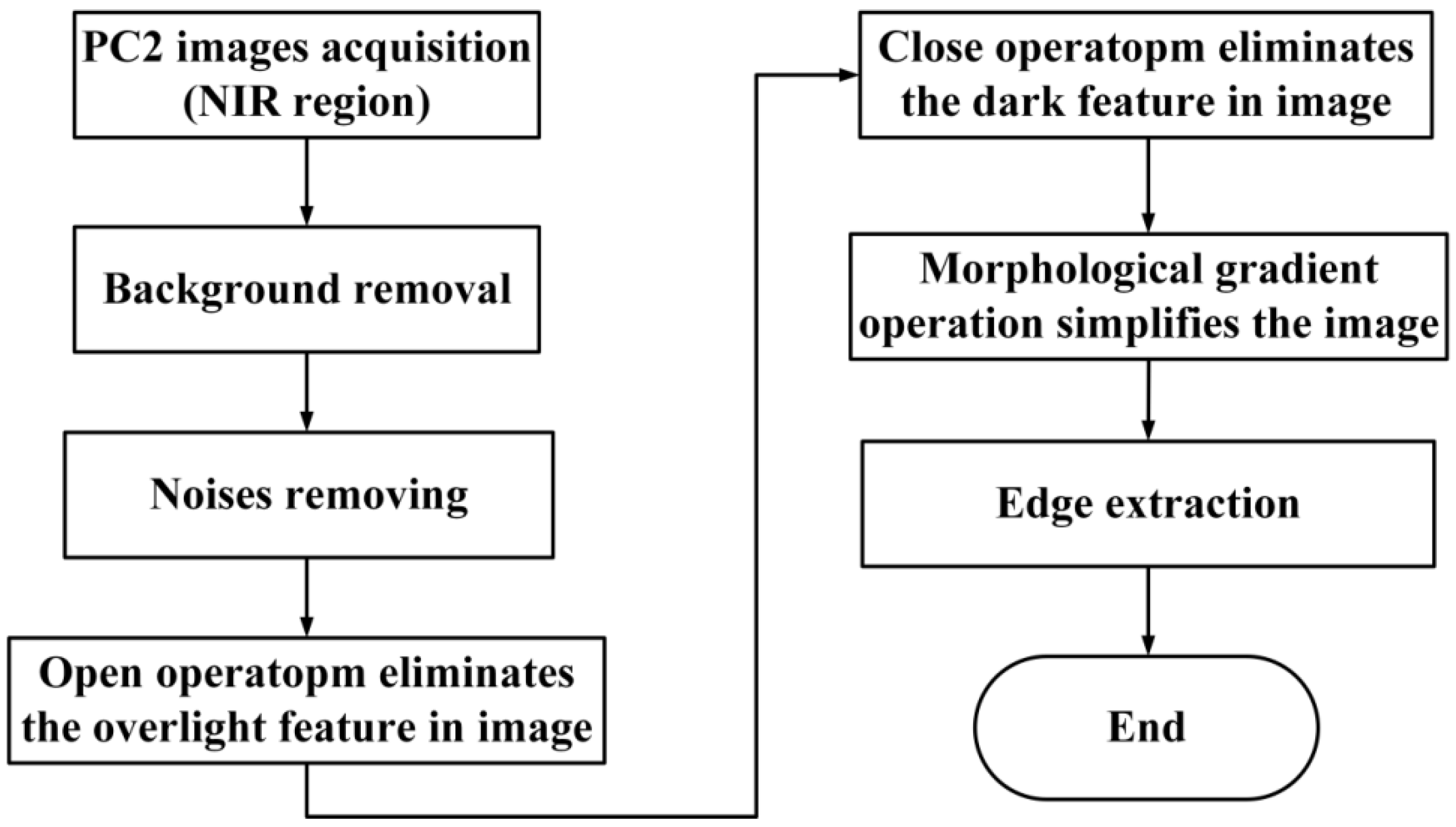

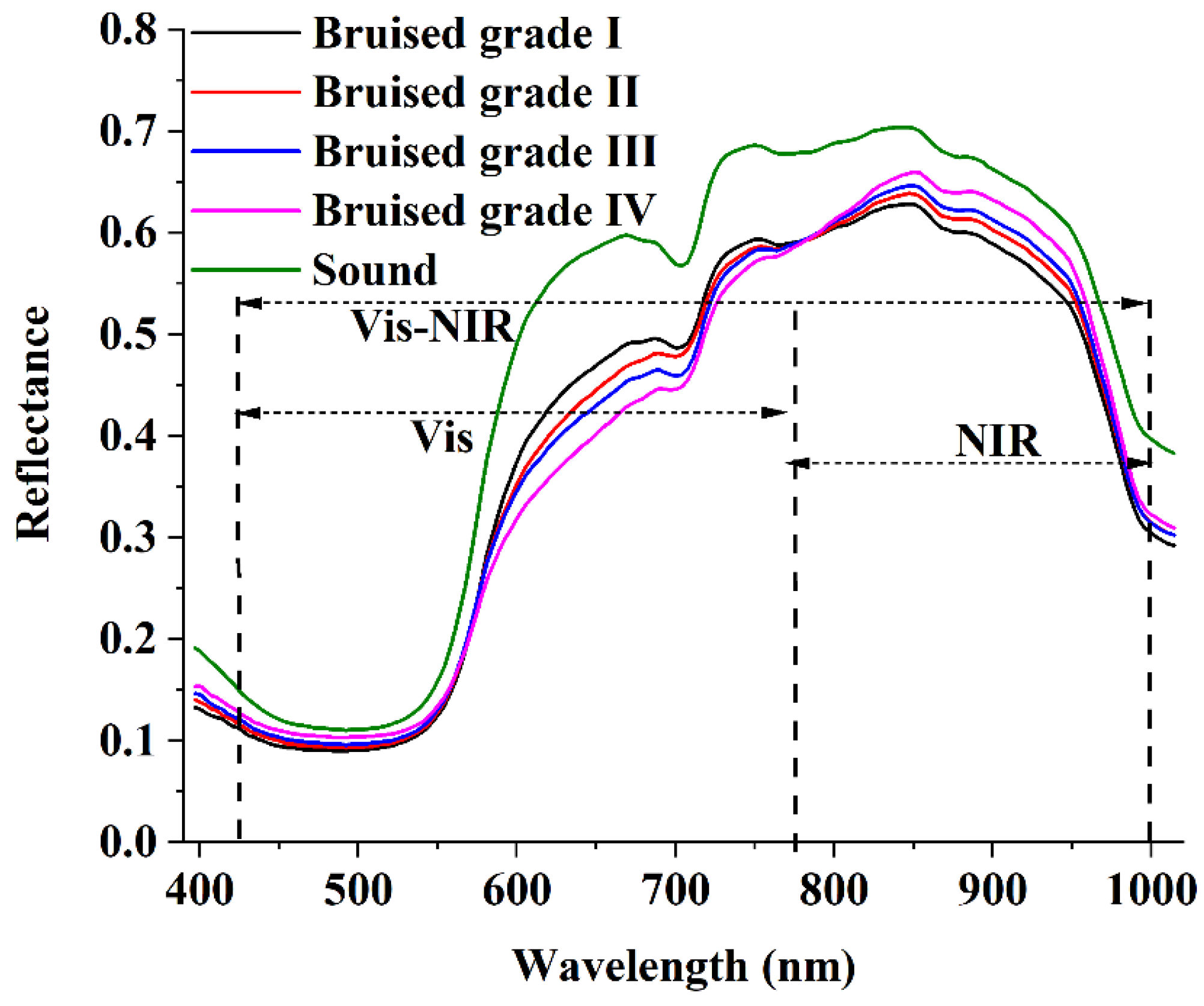

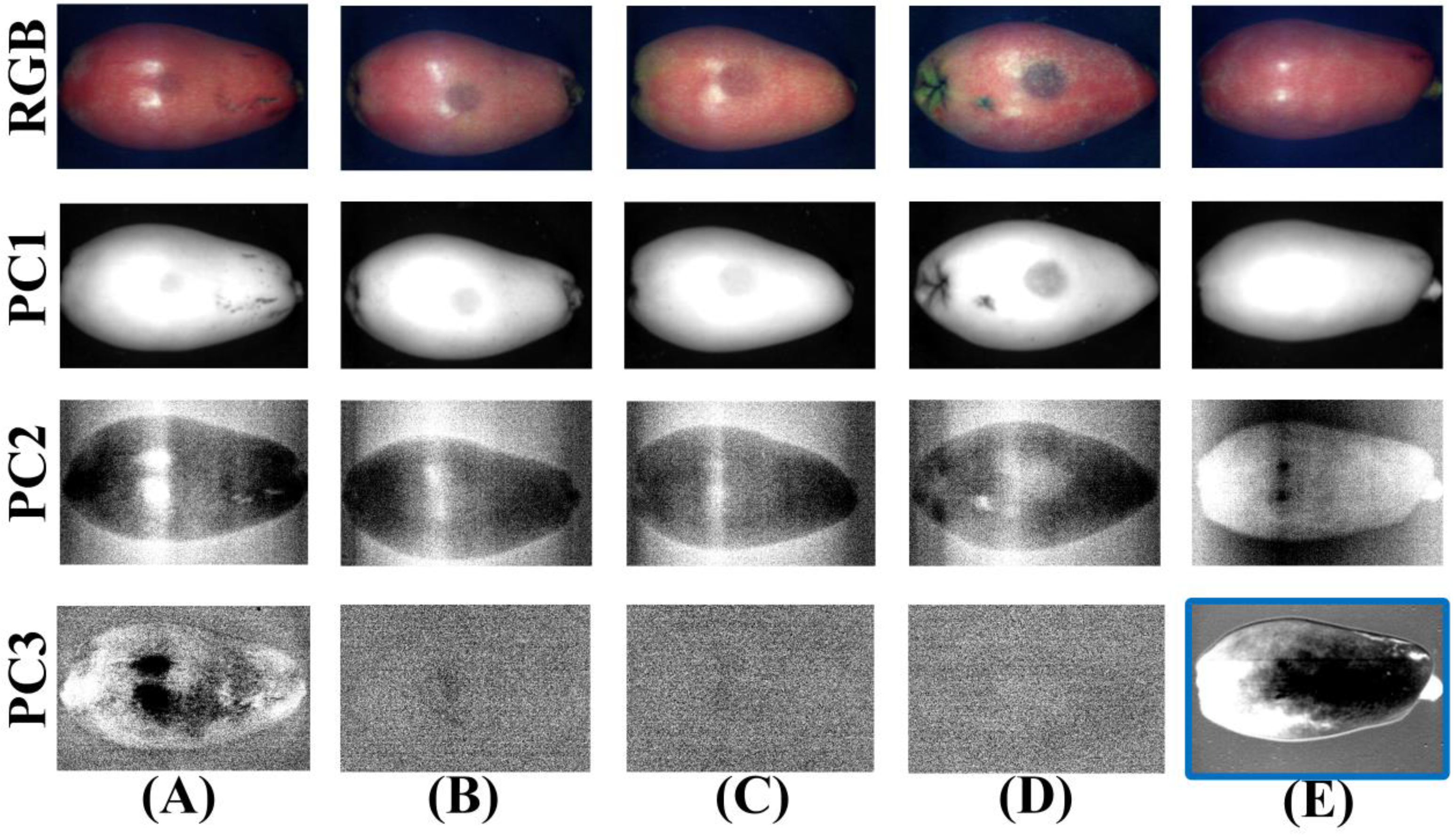
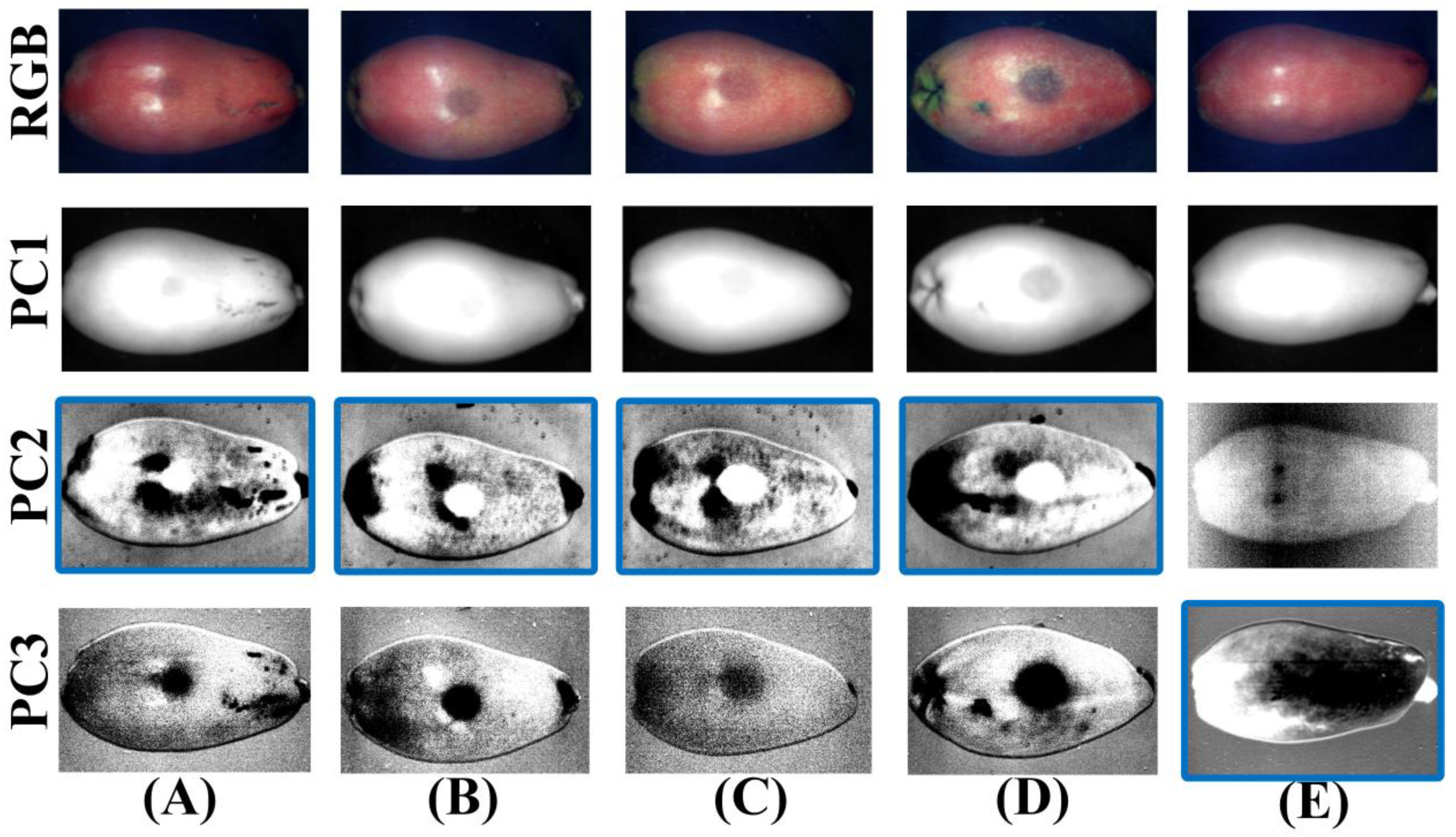


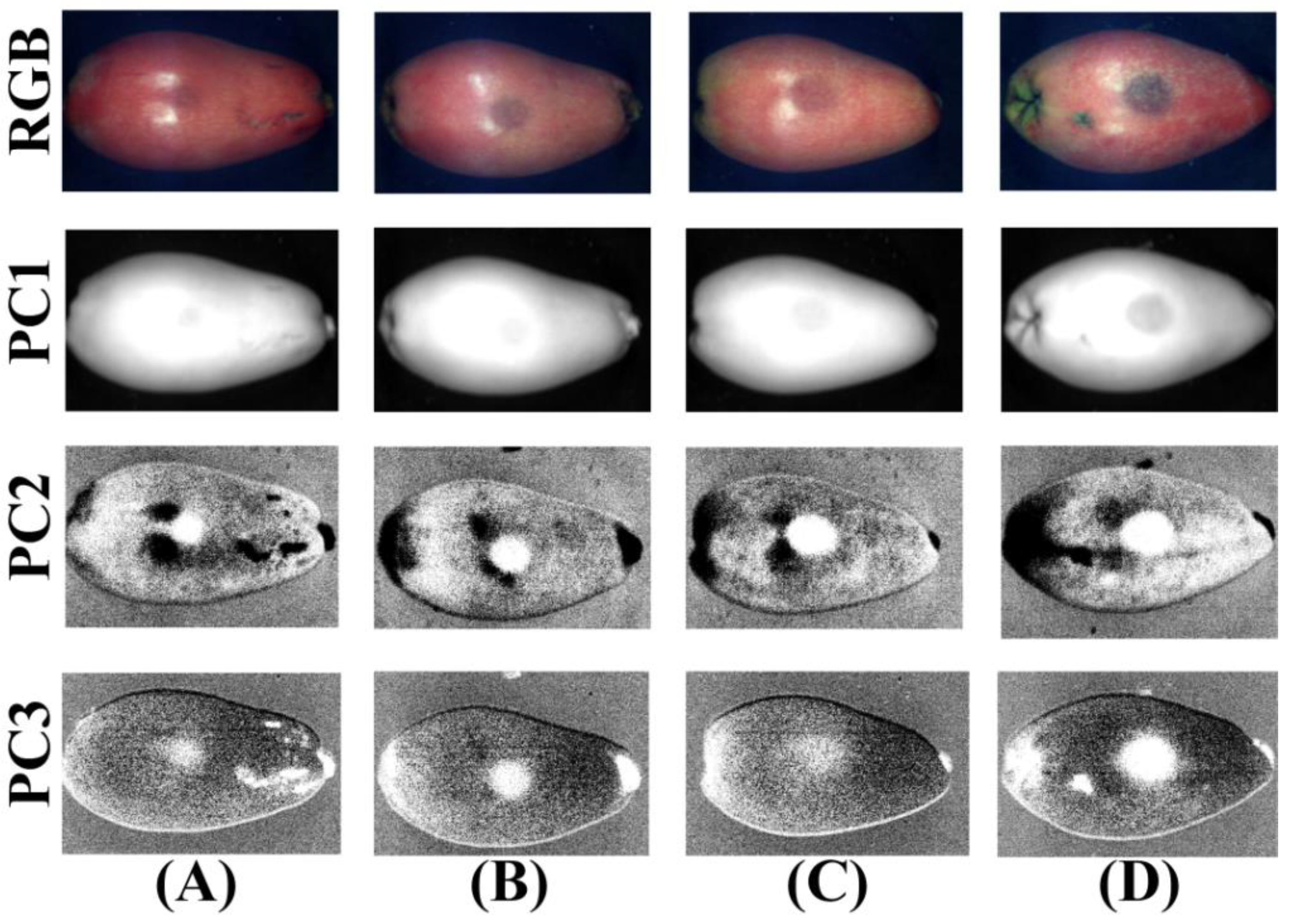
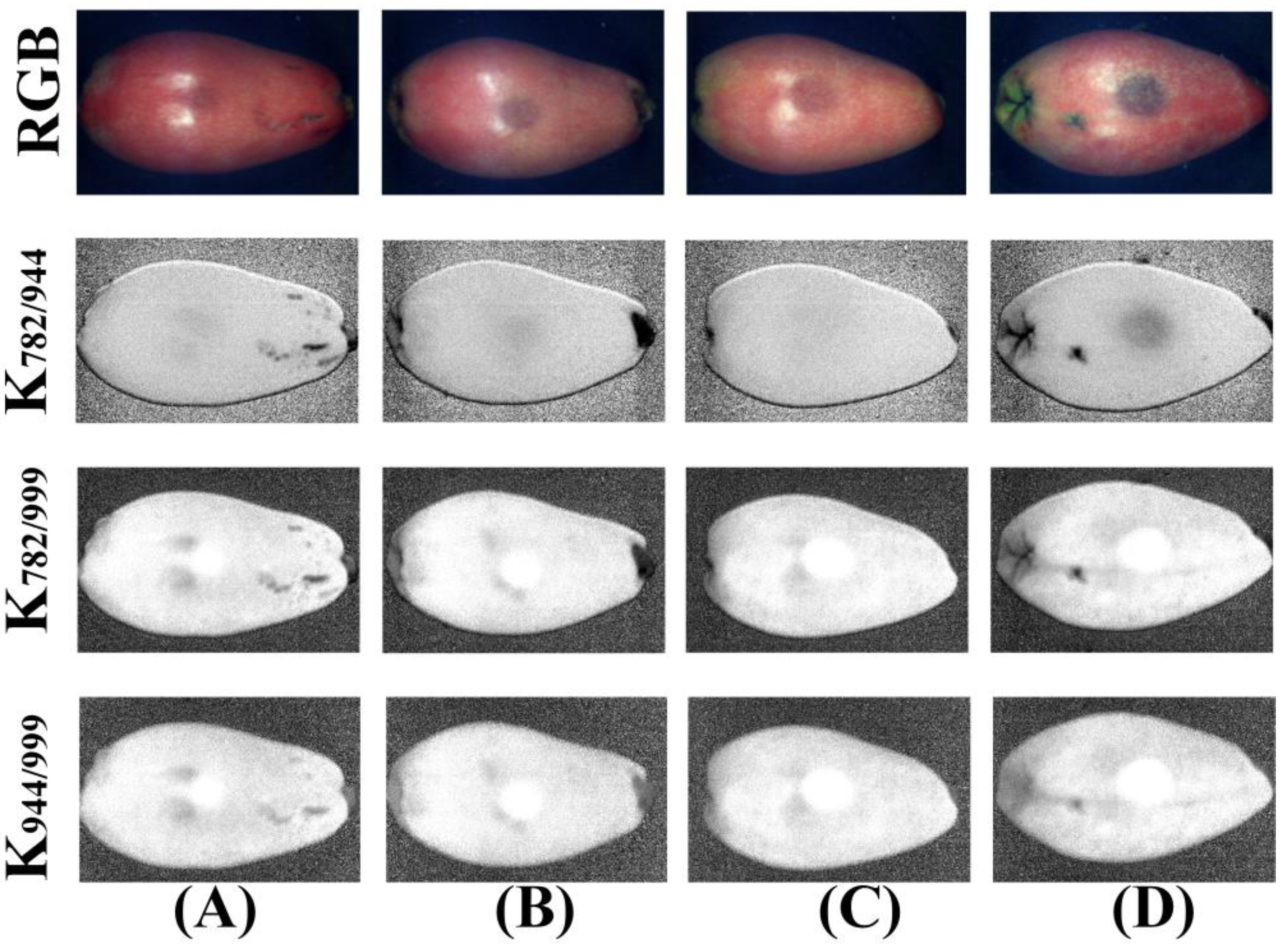
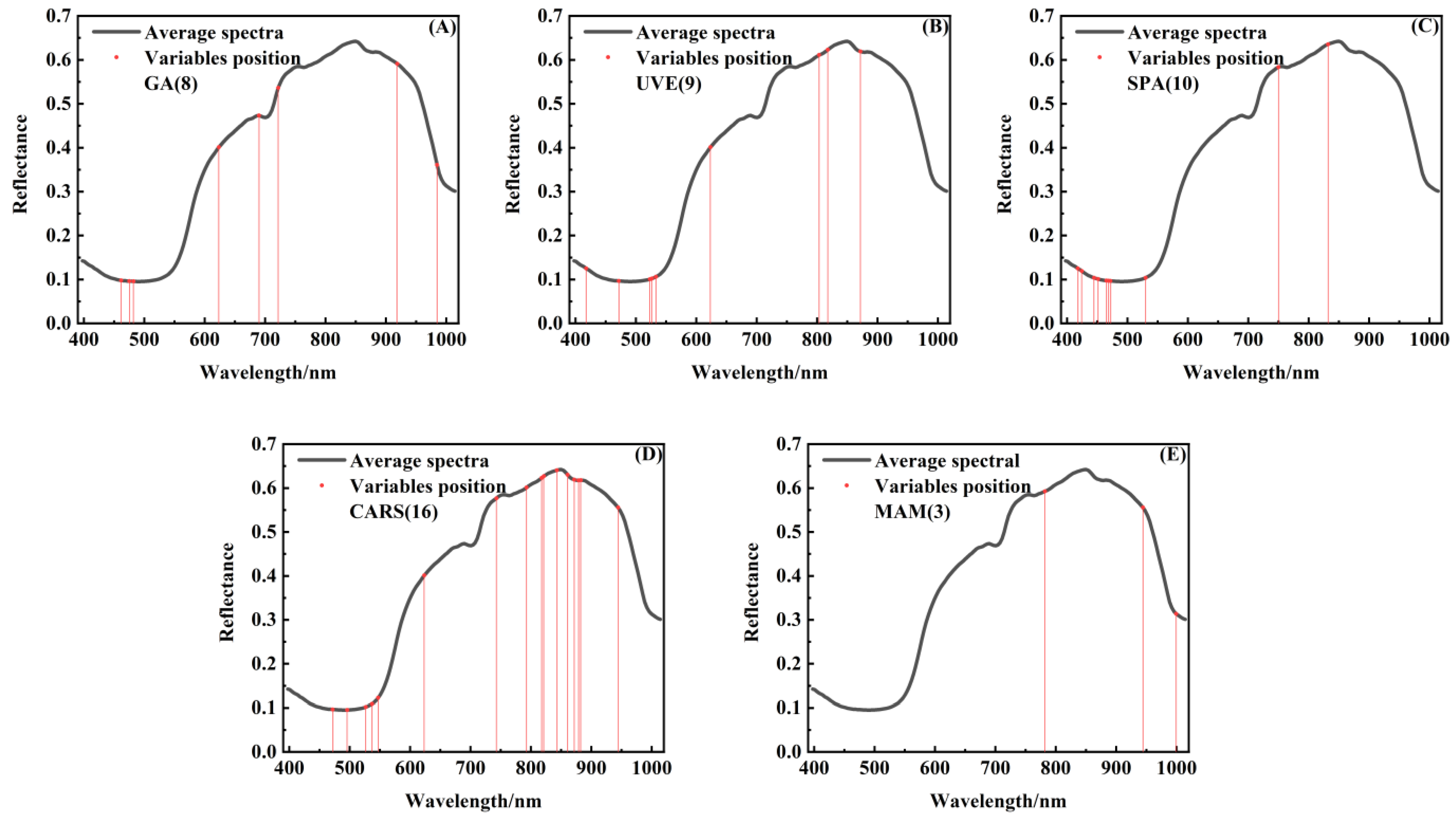
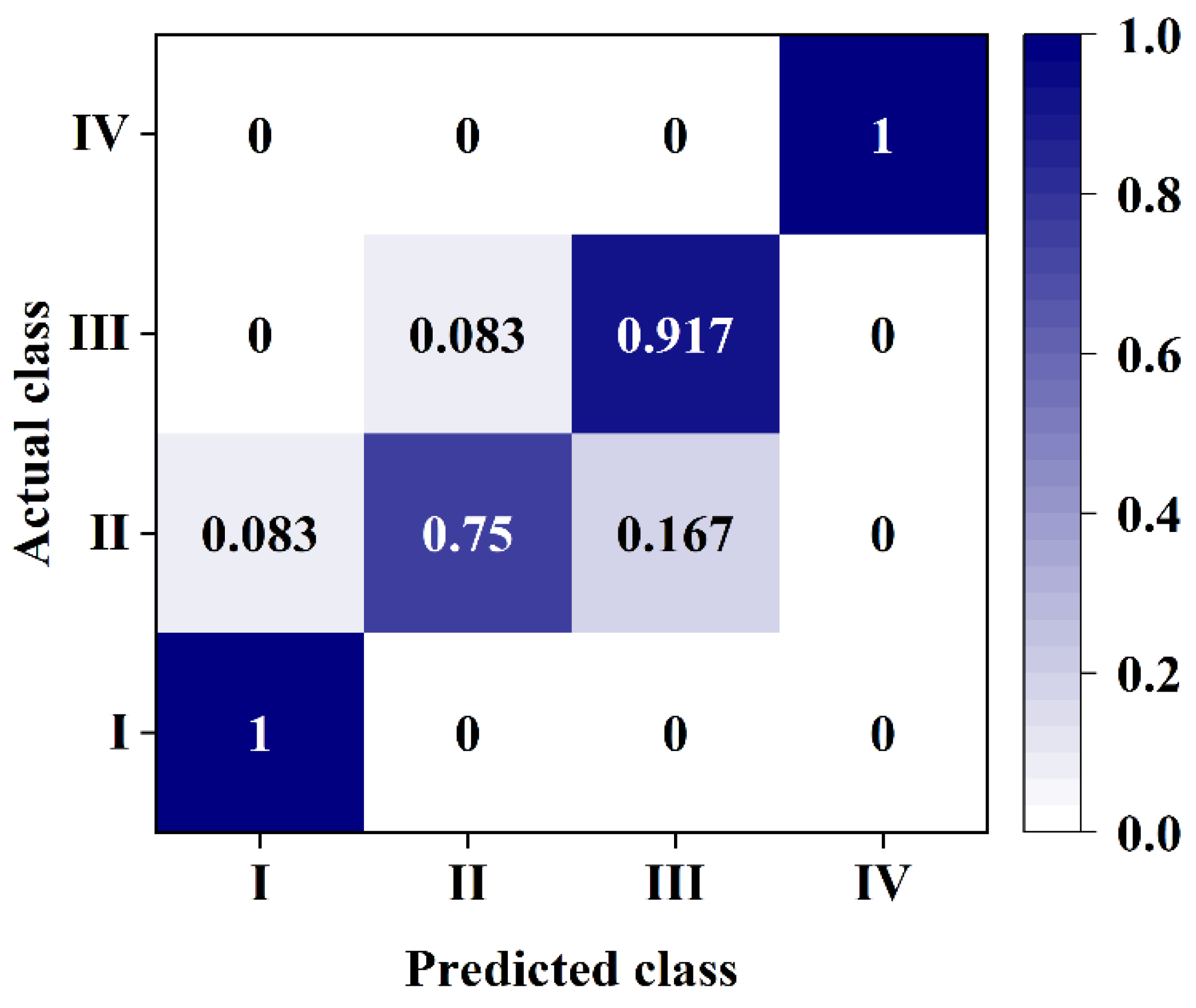
| Method | Number | Accuracy (%) | |||
|---|---|---|---|---|---|
| RBF | LIN | ||||
| S-LS-SVM | S-T-LS-SVM | S-LS-SVM | S-T-LS-SVM | ||
| Raw | 172 | 89.13 | 91.30 | 89.13 | 89.13 |
| GA | 8 | 86.96 | 86.96 | 80.43 | 80.43 |
| UVE | 9 | 82.61 | 86.96 | 80.43 | 80.43 |
| SPA | 10 | 82.61 | 89.13 | 80.43 | 82.61 |
| CARS | 16 | 84.78 | 89.13 | 84.78 | 84.78 |
| MAM | 3 | 91.30 | 80.43 | ||
Publisher’s Note: MDPI stays neutral with regard to jurisdictional claims in published maps and institutional affiliations. |
© 2022 by the authors. Licensee MDPI, Basel, Switzerland. This article is an open access article distributed under the terms and conditions of the Creative Commons Attribution (CC BY) license (https://creativecommons.org/licenses/by/4.0/).
Share and Cite
Li, B.; Han, Z.; Wang, Q.; Sun, Z.; Liu, Y. Study on Qualitative Impact Damage of Loquats Using Hyperspectral Technology Coupled with Texture Features. Foods 2022, 11, 2444. https://doi.org/10.3390/foods11162444
Li B, Han Z, Wang Q, Sun Z, Liu Y. Study on Qualitative Impact Damage of Loquats Using Hyperspectral Technology Coupled with Texture Features. Foods. 2022; 11(16):2444. https://doi.org/10.3390/foods11162444
Chicago/Turabian StyleLi, Bin, Zhaoyang Han, Qiu Wang, Zhaoxiang Sun, and Yande Liu. 2022. "Study on Qualitative Impact Damage of Loquats Using Hyperspectral Technology Coupled with Texture Features" Foods 11, no. 16: 2444. https://doi.org/10.3390/foods11162444






